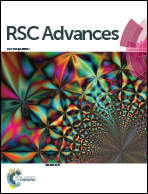The effect of different thawing methods on the health-promoting compounds and antioxidant capacity in frozen baby mustard†
Abstract
The effects of five domestic thawing methods, including air thawing (AIR), water thawing with bags (W + B), water thawing without bags (W − B), refrigerator thawing (REF), and microwave thawing (MIC), on the main health-promoting compounds and antioxidant capacity in both unblanched and blanched baby mustard were investigated in this study. The results showed that different thawing methods markedly affected the health-promoting compounds and antioxidant capacity of baby mustard. MIC better retained the overall nutritional quality of frozen baby mustard compared with the four other treatments. AIR led to significant decreases in the glucosinolate contents in unblanched and blanched baby mustard. W + B led to significant decreases in the total phenols contents and antioxidant capacity levels in unblanched and blanched baby mustard, as well as the ascorbic acid content in unblanched baby mustard. W + B led to a significant decrease in the FRAP level in unblanched baby mustard, as well as the glucosinolate and ascorbic acid contents and ABTS level in blanched baby mustard. REF led to significant decreases in glucosinolates and proanthocyanidins contents in unblanched baby mustard, as well as the ascorbic acid content in blanched baby mustard. Furthermore, the thawing time was greatly shortened by MIC (only approximately 1 min). Thus, MIC was the optimal thawing method for frozen baby mustard regardless of whether it was blanched, as MIC best preserved nutritional quality and reduced the thawing time.



 Please wait while we load your content...
Please wait while we load your content...